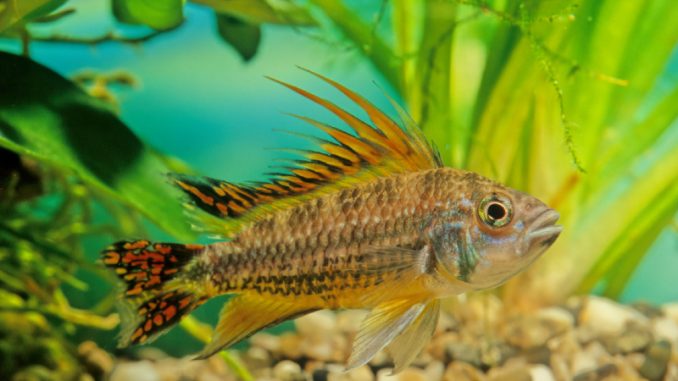
The cockatoo cichlid is a popular aquarium fish of the cichlid family, suitable for intermediate to advanced hobbyists with room for a mid-size aquarium. Named for their similar coloration pattern with the famous bird, cockatoo cichlids are known as generally peaceful creatures, except when they are breeding.
At this time, they become more aggressive. Despite this aspect of their character, cockatoo cichlids are timid and feel threatened by other, more aggressive fish. Cockatoo cichlids occupy the bottom and middle areas of the aquarium.
Their colors vary in the wild and in captivity as they are selectively bred to produce stunning color variations.
TABLE OF CONTENTS
Cockatoo Cichlid Facts & Overview
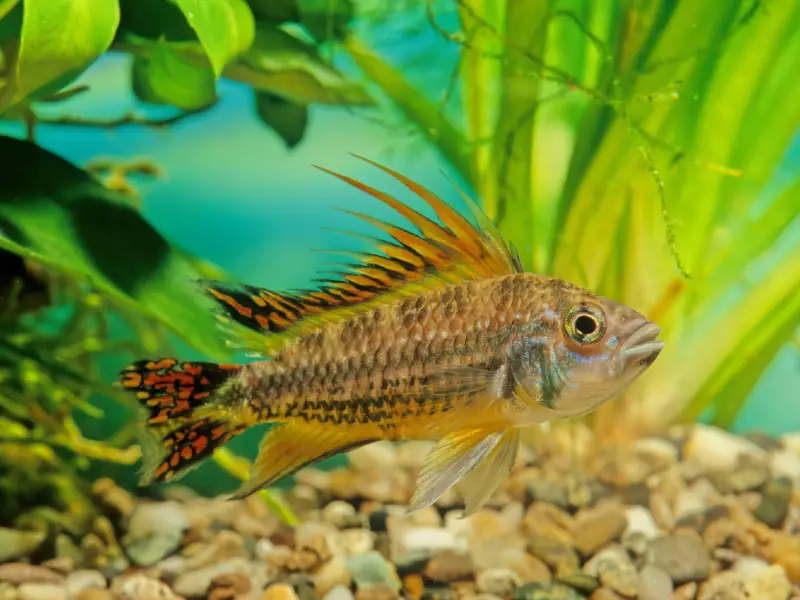
| Category | Rating |
| Care Level: | Moderate |
| Temperament: | Semi-aggressive (when breeding) |
| Color Form: | Blue, green |
| Lifespan: | 3-5 years |
| Size: | 2-3.5 inches |
| Diet: | Carnivore |
| Family: | Cichlidae |
| Minimum Tank Size: | 30 gallons |
| Tank Set-Up: | Densely planted freshwater |
| Compatibility: | Keep away from larger aggressive fish |
Hailing from the backwaters and streams of the Amazon River, the Cockatoo Cichlid is a smaller fish, reaching between 2 and 3.5 inches (5 and 9 cm). Females are slightly smaller than this. Also known as the Cockatoo Dwarf Cichlid or Big Mouth Apistogramma, its scientific name is Apistogramma cacatuoides.
In their natural habitat, Cockatoo Cichlids are accustomed to slow-moving water that is soft and mildly acidic. Accustomed to the South American Amazon heat, Cockatoo Cichlids enjoy temperatures of 79 to 84°F (26 to 29°C).
These cichlids have a lifespan of 3 to 5 years when provided optimal conditions.
You’ll notice that the colors of the wild Cockatoo Cichlids tend to be less vibrant than the captively bred fish; that’s because they are selectively bred to bring out vibrant hues.
Typical Behavior
Cockatoo Cichlids have a reputation for being mildly aggressive, but really they get territorial only when they are breeding, and also don’t like it too much when there are too many other male Cockatoo Cichlids around.
If you are planning to keep multiples, make sure they have plenty of room. They don’t have issues with their own if they have space to stake out their own tank space.
Other than that, Cockatoo Cichlids are pretty mellow and unassuming, and they get along with other species, so they are good community tank choices.
Cockatoo Cichlids are shy and need hiding places, so you’ll need to provide them with plants and caves. Additionally, they are cave breeders, so if you’re planning on breeding them, the caves will serve a double purpose.
Because the type of aggression they display is a result of feeling threatened, you have the opportunity to defuse their behaviors in significant ways. Providing a large enough tank and the plants and caves suggested, Cockatoo Cichlids will be able to avoid constant run-ins that bring them stress and cause them to feel territorial. When fish are less stressed, they are able to calm down.
One behavior that might seem odd is that the male Cockatoo Cichlids eat sand–at least, they appear to eat sand. Really, they are looking for food scraps in the substrate. They will spit out the actual sand. Don’t be concerned about this practice–it’s perfectly normal for Cockatoo Cichlids.
Appearance
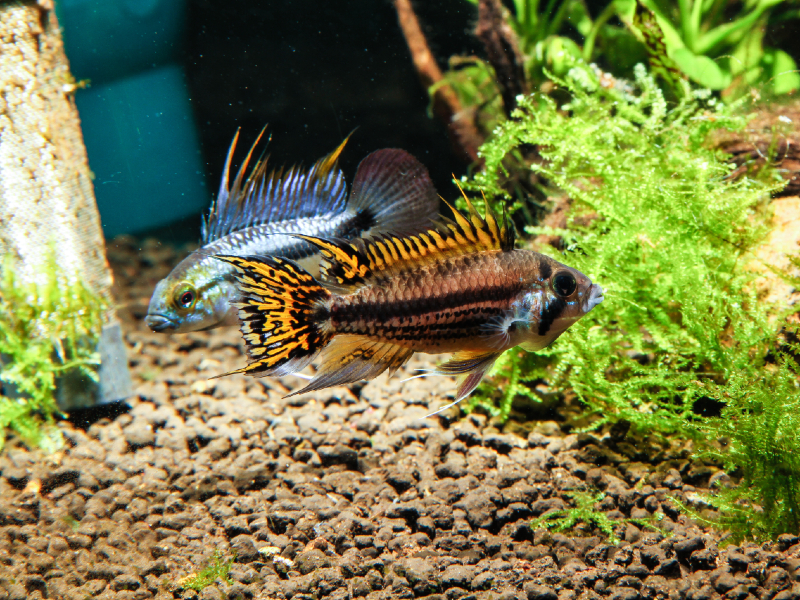
The Cockatoo Cichlids that are commercially bred in captivity are selectively bred to showcase a stunning orange hue on the rear of their dorsal fins and their tails. They have grey bodies with black lines that trace the entire length of the fish starting at the eye.
Their orange dorsal fins are prominent, their bodies are long, and they have large mouths.
Cockatoo Cichlids vary in their coloration; in addition to the orange, some of the red varieties include full, double, triple, and super.
Although the colors in the captive-bred fish are brighter, both the wild-born and captive Cockatoo Cichlids have gorgeous fins.
Distinguishing between males and females
Male Cockatoo Cichlids are 2 to 3.5 inches (5 to 9 cm) in length; the females are a little smaller, a cichlid feature.
The males sport more vibrant colors than the females. Also, their tails are forked and they have pointed anal and dorsal fins.
During reproduction, there are significant color milestones as well. When the males are trying to attract the female’s attention for breeding, their colors transform and appear more vibrant. This color change accompanies a dance they perform to attract the females’ attention.
After fertilization, when the females are tending to their eggs, they have a combination black and yellow color combination.
Habitat and Tank Conditions
Cockatoo Cichlids will do best with a fine sand substrate. Gravel is not a good option; because Cockatoo Cichlids are bottom dwellers and scavenge in the substrate for food, gravel could damage their underbellies, and open wounds may get infected.
Choose a dark color sand that is reminiscent of their home near the Amazon River.
These fish need a densely planted tank along with decorations, driftwood, and caves. Despite the need for substantial hiding and breeding spots, you also need to make sure to leave them enough open swimming space. That’s why you need to make sure you have a long enough tank to accommodate all their space needs.
They will use caves for hiding and for spawning. You should provide more caves than you have females, and space them apart.
Water Conditions
If your room never gets below 60 °F (15.6 °C), you don’t need a separate heater. However, should you choose to get one, you should keep it in a range of 72 to 74 °F (22.2 to 23.3 °C). Cockatoo Cichlids do not do well with drastic fluctuations in temperature.
Be sure to do regular water checks and perform bi-weekly partial water changes.
The optimal parameters to ensure healthy Cockatoo Cichlids are:
- pH : 6.0 – 7.0
- Water hardness: dKH 2-15
- Temperature : 79 – 84°F (26 – 29°C)
What Size Aquarium Do They Need?
You will need at least a 30-gallon tank for Cockatoo Cichlids; although they are not large fish, they need swimming space and they need space to hide and get away from it all. The length of the tank is more important than the depth for Cockatoo Cichlids since they will stay in the bottom section of the aquarium.
Tank Mates
Cockatoo Cichlids are peaceful unless they are breeding or threatened, so they are good community tank inhabitants. I recommend sticking to fish that are similar in size, as well as fish that are peaceful and non-aggressive. Even though Cockatoo Cichlids are sometimes aggressive, they are also shy and will be stressed around fish that are aggressive and also those that are super active.
Since Cockatoo Cichlids are mid-to-bottom dwellers, you could also pair them with upper tank dwellers since Cockatoo Cichlids will not venture to the top of the tank and therefore they won’t interact.
Suitable tankmates:
- Glowlight Rasboras
- Kuhli Loach
- Dwarf Gourami
- Dwarf Rainbow Fish
- Cardinal tetras
- Julii Cory
Unsuitable tank mates: (because Cockatoo Cichlids will eat them)
- Crabs
- Shrimp
- Snails
Keeping Cockatoo Cichlids Together
Cockatoo Cichlids do get along together, but it’s a good idea to limit the number of males that you keep in one tank, and you should also provide them space to stake out their own territory in the tank in order to avoid confrontations.
If you have a dedicated, single species tank, you should keep 1 male and 5 or 6 females — this is called a harem. If you are able to keep a larger tank, you can try more than one male, making sure they have enough caves and plants to keep their distance.
Care
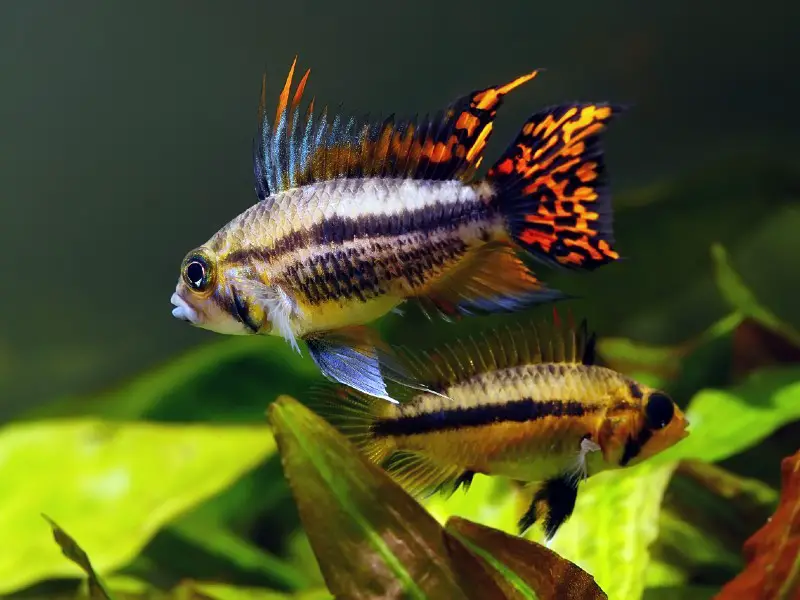
Even if you maintain optimal conditions in your community aquarium, and even if you manage to keep your Cockatoo Cichlids stress-free, there is always the chance that your fish will be stricken with a disease. Cockatoo Cichlids are susceptible to the same parasitic, bacterial, and viral infections that all freshwater fish are prone to.
Certainly checking water parameters regularly, avoiding temperature fluctuations, and performing regular water changes will decrease the chance that your Cockatoo Cichlids will fall ill. Irregularities in the water environment cause physical stress, and feeling crowded and threatened creates emotional stress.
Stress of both kinds reduces the quality of life and weakens immunity, increasing the chance of disease. Some common diseases to watch out for in Cockatoo Cichlids are ich, a parasitic infection; skin flukes; worms; and bacterial infections. Skin flukes can also lead to open wounds that become infected.
Most fish diseases can be treated with over-the-counter medications. Most of these have copper, which is toxic to shrimp, snails, and even some fish. If you need to use copper medication, you should move your Cockatoo Cichlids to a separate tank to treat them.
There are also non-copper versions available. With proper tank maintenance, high-quality water and food, and no sudden changes in the aquarium, diseases should not be a problem.
It is vital to treat and quarantine any new plants, decorations, fish, or invertebrates before adding them to an established tank. Anything coming from outside can bring disease into your aquarium, and disease spreads quickly.
Diet
Cockatoo Cichlids are full carnivores that require a variety of protein nutrition choices. In their natural habitat in South America, the main sources of food for these predators are insects, larvae, and worms.
In the controlled environment of your home aquarium, Cockatoo Cichlids are amenable to many food choices. They will take flakes and pellets; live food such as brine shrimp, crustaceans, insects, and worms; and freeze-dried foods including bloodworms and tubifex.
You do need to take care that your feeders are properly sourced, or if you have room, you can raise your own feeders in a separate tank.
Breeding
Cockatoo Cichlids spawn their eggs in caves. Admittedly, the process is not easy in your home tank. You may choose to let the professional breeders do their thing.
Nonetheless, I’ll explain the process. Prior to a breeding attempt, you should start them on a rich diet of live foods that will provide the nutrients necessary for successful reproduction. Try foods such as brine shrimp, cherry shrimp, daphnia, black worms, and earthworms.
Make sure to space out multiple caves for spawning. Since the males are pretty territorial, I recommend one male for every three females.
If the male is successful in courting the female during the dance I spoke of before, the female will lead the male to one of the caves. She will lay her eggs and invite the male to fertilize the eggs.
After the male Cockatoo Cichlids fertilizes the eggs, his job is done. The fertilized eggs are then protected by the female until they hatch.
The fry hatch in a week to 10 days, and they are free-swimming right away. However, the female Cockatoo Cichlid guides them around the tank for weeks, making sure they get enough to eat. Fry should be fed baby brine shrimp and microworms. The Cockatoo Cichlid fry develop quickly, and they reach sexual maturity within five months.
Are Cockatoo Cichlids Suitable for your Aquarium?
Cockatoo Cichlids are small but mighty. They’re beautiful to look at, fun to watch, and great community additions.
Since Cockatoo Cichlids fare better in an established tank, they’re a great choice if you’re looking to add a mid-to bottom-dweller to your community aquarium.
Just be sure to quarantine them for 14 days before adding them into the tank so as not to spread diseases. Also, make sure that you have enough room in your tank for the Cockatoo Cichlids to spread out and avoid confrontations.
Add a few of these fish and I guarantee that your aquarium will get some well-deserved attention.
Do you think Cockatoo Cichlids are the standout of your community aquarium? Let me know why in the comment section, and thanks for visiting the page!

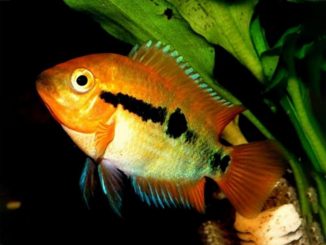
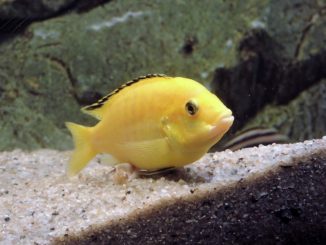
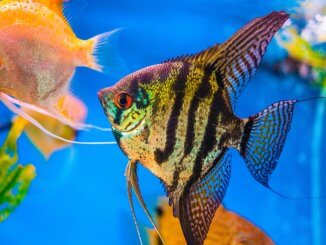
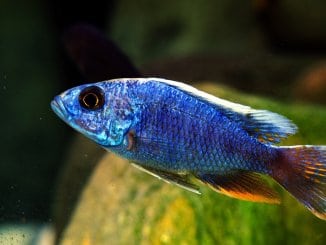

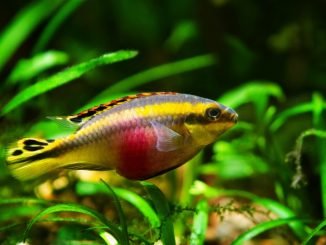
Thanks for your information on aquarium fishes, I find them very helpful, I’d never heard of cockatoo cichlids before.